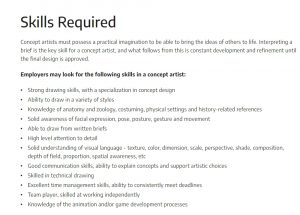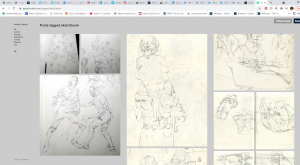Out of all these possible jobs within the industry, I think I’d definitely want to work in the development/ pre-production/ production stages. I’ve always liked the idea of a concept artist, coming up with the first initial ideas/looks/sketches for an animation, following the information and story made by the writer. Working with the writers, producer, and head of story to produce a style for the animation. They provide visuals and references for animators, background artists, and character designers. I like how much influence they have, but they require a lot of technical drawing/painting skills and normally in short time frames, which I’m not confident if I could manage that right now. This job probably wouldn’t have a showreel but instead a still image portfolio.
I also feel like a modeller/model maker would be cool, actually building the versions of everything that is seen on screen in an animation. I also like working from concept art, character designs and environment designs. I think I’d like to be a character modeller/sculptor, I spent the summer looking at and trying to emulate Omar Smith’s recent sculpts, a visual development artist at Sony. You would probably work from a character concept for this, from a character designer which might be what I’m more interested in. This job could have a showreel more focused on turnarounds showcasing the models, I feel like this could be made easier by just linking a Sketchfab account though, allowing employers to view models how they wanted.
What does a Character Designer do?
 Character designers visualise and create the look of characters, from descriptions given by the director. These might include notes on a character’s personality and/or physical traits. Character designers take inspiration from the script and concept art to design characters and communicate the characters’ personalities through artwork.
Character designers visualise and create the look of characters, from descriptions given by the director. These might include notes on a character’s personality and/or physical traits. Character designers take inspiration from the script and concept art to design characters and communicate the characters’ personalities through artwork.
Character designers carry out research into the anatomy of characters and relevant fashion styles to inform their work. This role relies heavily on drawing ability. Character designers create a variety of designs for a single character. They present these to the director and address any of the director’s feedback to achieve a result that they are happy with.
Once a design has been approved, character designers create ‘model sheets’ which show the character from different angles. In 3D animation, these will be used by the modellers to create the characters. In 2D animation, the animator uses the model sheets to ensure each frame of animation is “on model”.
Shiyoon Kim – Character Designer
Shiyoon Kim is a Korean-American character designer and concept artist previously at Walt Disney Animation Studios and Sony Pictures Animation, He is responsible for designing and helping bring characters to life from Tangled, Wreck It Ralph and Big Hero 6. My favourite of his work is on Big Hero 6 and Spider-Man: Into the Spider-Verse. I think a character design/ concept art job would be great to have, since you are directly responsible for creating iconic characters that the audience connects with – someone eye-catching and memorable. they must truly understand and conceptualize the character’s personality and backstory and therefore have a large influence on the project. Shiyoon Kim didn’t have a showreel to study obviously, instead he uses a website showcasing still images.
What does a Look Development Artist do?
A job I find interesting that I’ve heard of before is a look development artist, that wasn’t mentioned in the above list from screenskills for some reason.
If a concept artist draws an alien, then the look development artist works out what the skin of the alien will look like in different conditions – when it’s raining, when it’s dark, when the creature’s angry. They work with lighting TDs, texturing artists and creature TDs to establish the different looks, balancing the processes of texturing, lighting and rendering to match reference images and real footage.
As the title suggests the Look Dev Artist focuses on the development of the visual style of the animation or the game. Overseeing all elements such as layouts, environments, characters, objects, assets, etc are in line with a uniform look. This involves setting the style, color scheme, genre and execution of the artwork.
Jeffrey Thompson – Look Development Artist
This is a look dev artist I found online, Jeffrey Thompson. He contributed a variety of design work, ranging from background and character paintings, to 2-D animation for Into the Spider-Verse. It looks similar to a concept artist, probably a job role for someone with experience or seniority, since a lot of these guys I find online seem to also seem to double up as art directors and I can’t seem to find any entry level positions for it. It looks like a great job with a lot of input in the final look of the project, which is always cool.
This website cgspectrum was great for seeing the different skillsets needed for different job roles, as well as more information like responsibilities, roles, software and salarys. Of course the lists have a lot of similarities since I was looking at pretty similar job roles and most of the time jobs in animations will require similar vague skillsets anyways since they’re rooted in art/design, such as; attention to detail, team player and ability to work independently, desire to learn new technologies techniques, knowledge of the pipeline, able to produce multiple revisions of artwork as briefed, comfortable with taking constructive criticism, good communication and interpersonal skills, ability to work under pressure and consistently meet deadlines. The more specific skills can be seen above, which in the above roles were often software/tool based.
 Entry Level Position for me: Animator (junior)
Entry Level Position for me: Animator (junior)
Animators create still images played in a rapid sequence to create the illusion of movement. They are artists, actors and storytellers. They know how characters show emotion and a have a technical understanding of the way things move. They make a believable world through the blend of realism and artistry.
Animators take a visual brief from a storyboard and a verbal brief from a director. From the brief, they create the drawings, models or computer images in a way that gives the illusion of movement.
Within that, there are different kinds of animators: 2D/traditional animators, 2D assistant animators/in-betweeners/clean-up artists, 2D puppet/rigged animators, 3D/CG animators, stop motion animators.
A lot of the jobs you find online aren’t actually in Belfast, it just says they are if they support remote work, but I managed to find a job opportunity at a local studio, Taunt. I think I’d like a 3D animation or modelling job, it seems like a fun job and you’d have more of a generalist role if you get into a small studio like Taunt, which would be good while I figure out my speciality. I’m not set on just 3D work, I would like a 2D job role too which is why I looked at concept/character design, but I don’t think my 2D skills are quite at that level yet.
This job looks good for a graduate with a year in industry, since they require at least one year experience. It seems like a great opportunity, so I’ll use this as my example. The skill set required lines up well with the skills we gain on our course, working closely with a team to deliver assigned shots, communication, knowledge of the animation pipeline in Maya, time management skills, independent work, etc.
 If I was applying for a 3D Animator job like this, I would need to cater my show reel to it. I found some helpful YouTube videos covering what a show reel for this should look like and I should be able to make one out of the content I’ve produced so far in Uni. I’ll do more research into this when it comes to actually making my show reel – but this job role seems like a good idea to go ahead with.
If I was applying for a 3D Animator job like this, I would need to cater my show reel to it. I found some helpful YouTube videos covering what a show reel for this should look like and I should be able to make one out of the content I’ve produced so far in Uni. I’ll do more research into this when it comes to actually making my show reel – but this job role seems like a good idea to go ahead with.
Junior/Mid-level Artist Research:
Arielle Estrella
She graduated from the American Academy of Art in 2015 and according to her LinkedIn and resume, didn’t get any work until 2018 – Where She Designed VFX and created final Unity assets for various console and mobile games. Once she got her foot into the industry though she got a lot of amazing opportunities. She went on to work with Alberto Mielgo, modeling vehicles, street props, vehicle variants, and painting texture variants for the “Watchdogs: Legion – Tipping Point” cinematic trailer.
Since then she has worked as a generalist in various freelance and contract roles. She has also grown a pretty significant following on her twitter, this is where I first discovered her and really enjoyed her art style, both 2D and 3d. She is still pretty junior/mid level and its good to see even though she didn’t get work at first, she now has a decent social media following and a lot of great projects under her belt. It seems as if the hardest job to get, at least in her situation, is the first one. After you secure that first job though, it becomes easier to find work.
References:
https://www.screenskills.com/starting-your-career/job-profiles/animation/
https://www.linkedin.com/jobs
http://www.shiyoonkim.com/
https://www.northernirelandscreen.co.uk/
https://www.youtube.com/channel/UCd4tG1v5ii8z9IG1i9SI_Tw#
https://www.youtube.com/channel/UCH64i_nElTFZlYE98oN8Idw
https://www.linkedin.com/in/arielle-estrella-320238217/
https://aeryel.tumblr.com/
https://www.cgspectrum.com/
















